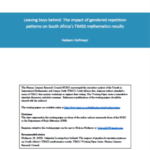Leaving boys behind: The impact of gendered repetition patterns on South Africa’s TIMSS mathematics results

This paper analyses gender differences in South Africa’s TIMSS Grade 9 mathematics achievement, with particular emphasis on the role of gendered grade repetition and dropout patterns in contributing to an apparent pro-girl gap in mathematics achievement. I make use of Oaxaca-Blinder decomposition analysis to decompose the observed pro-girl gap into its explained and unexplained components, separately by school socio-economic quintile. I present new evidence that there are important selection effects at play that influence the observed pro-girl gap in TIMSS mathematics achievement. In particular, comparing the size and age distributions of males and females in the Grade 9 TIMSS sample shows that boys are more likely to have dropped out of school and twice as likely as girls to have repeated a grade by Grade 9. Multivariate regression analysis suggests that males are more likely to be “weeded” out of their cohort as they progress through school, even when they are similar to females along a number of dimensions, including academic achievement.
